#Émile Gaboriau
Text
A Study in Scarlet: The Science of Deduction
I am reusing some stuff from my December 2022 post on this.
A portmanteau was a large travelling bag that opened into two parts; it has since become a term for a "blended word" i.e. two words combined to make a single one, like "gerrymander" or "infomercial".
We get a small bit of antisemitism in this one - Watson refers to someone as looking like a "Jew pedlar". This is a period when that was rife - and it would get worse as time went on. A lot of the population of the East End would be made up of Jewish refugees from the Russian Empire.
Central London is small enough that you can walk across it in a couple of hours; I did a 10-mile charity walk earlier this year that covered a good part of the City (which is a distinct political entity to Greater London) and the East End. You can get a vast range of architecture in a small distance.
The London Underground was definitely a thing by 1887, although only the "sub-surface lines" had been built by that point. The Bluebell Railway has some Metropolitan Railway carriages of a slightly later vintage that I believe have turned up in more than one Holmes adaptations; you can also find examples you can go in at the London Transport Museum.
A railway porter - something that I have done at a heritage railway - was a general "servant" who did things like assist customers, carry luggage, sweep up and other general duties. They weren't supposed to accept tips from passengers, but the practice was widespread.
Dupin is one of the first literary detectives.
Émile Gaboriau wrote 11 works featuring Lecoq before his death in 1873 aged just 36.
19 notes
·
View notes
Text

Alredered Remembers French mystery writer and journalist, a pioneer of modern detective fiction, Émile Gaboriau, on his birthday.
0 notes
Text
Happy Father's Day
“A father is the one friend upon whom we can always rely. In the hour of need, when all else fails, we remember him upon whose knees we sat when children, and who soothed our sorrows; and even though he may be unable to assist us, his mere presence serves to comfort and strengthen us.” —Émile Gaboriau

View On WordPress
0 notes
Text

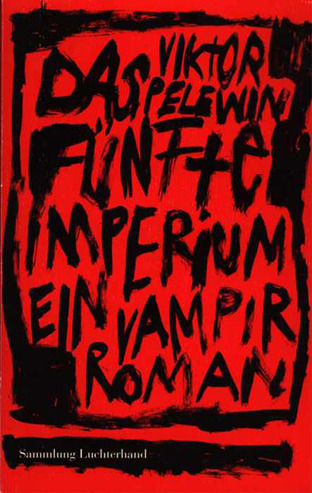
Endlich einmal wieder ein Vampir-Roman. Vampire sind aber ganz anders als man erwartet. Sie haben heimlich die Weltherrschaft an sich gerissen, benützen und unterhalten die Menschen mit Geld und wie Milch-bzw.-roter-Saft-Kühe bei Mozartklängen, pflegen Glamour und Diskurs und spiegeln damit auf sonderbarste die moderne russische Gesellschaft wieder.

Ein früher Criminal-Roman. Aufgrund widriger Umstände wird der Held des Mordes verdächtigt, kann den wahren Schuldigen aber nicht benennen. Ist vergnüglich, voller ergötzlichem Standesdünkel und Intrigen und zur Entstehungszeit war das ja auch möglicherweise noch ein neuartiges Handlungskonstrukt.

Der junge Lèmpriere hat möglicherweise Anspruch auf ein großes Vermögen, das ihm eine übelmeinende und vor bizarren Morden nicht zurückschreckende Geheimgesellschaft aber mit allen Mitteln und seine seiner enormen klassischen Bildung geschuldeten Naivität ausnutzend, vorzuenthalten versucht. Dafür schreibt er ein umfassendes Nachschlagewerk. Ist episch, vertrackt, groß und wundersam, und sogar mit Piraten! Sie sind aber schon sehr alt.

Während eines Dante-Kongresses in Rom werden im Rahmen eines Pfingstwunders sämtliche Teilnehmer bis auf den handfesten Erzähler entrückt, der das nicht verstehn noch recht einsehen mag. So albern das ist, erfährt man doch einiges über die Commedia, was mir bei der Verfilmung sehr zugute kam (vgl. hier).

Der junge Dännenprinz Hamlet wirkt gelegentlich etwas unentschlossen (”Seyn oder nicht seyn”), eine Eigenschaft, die der schwäbsiche Besserwisser durch subtile Weglassungen und eine einmalige Bewertungsfußnote noch vertieft, der damit für die Einschätzung der deutschen Romantik verantwortlich gemacht werden muß (Eigentlich rate ich in diesem Falle zur Erich-Fried-Übersetzung). Dies diente der Vorbereitung für ein größer angelegtes Hamlet-Projekt.

In Iris Murdochs Meisterwerk The Black Prince, wird auch über Hamlet diskutiert, allerdings nicht so, wie ich erwartet hatte. Dafür über die Liebe, die Literatur, die Eifersucht, die Selbstüberschätzung, die Leidenschaft, den Neid und die Unfähigkeit, ein literarisches Meisterwerk zu schreiben. Zumindest über letzteres hätte sich Iris eigentlich keine Sorgen machen müssen.

Als weitere Huldigung zum Dostojewski-Jubiläum noch der erste Band von Eckhard Henscheids legendärer Trilogie des laufenden Schwachsinns, ein historischer Roman aus dem Jahr 1972 mit dem schlüssigen Titel Die Vollidioten, in dem eine Gruppe Frankfurter Tunichtgute eine Menge alkoholischer Getränke zu sich nimmt und sich Gedanken macht, welches Fräulein sie wohl als nächstes flachlegen können.
#Buch gelesen#Viktor Pelewin#Das fünfte Imperium#Vampire#Émile Gaboriau#Der Strick um den Hals#Lawrence Norfolk#Lèmpriere's Dictionary#Sibylle Lewitscharoff#Das Pfingstwunder#William Shakespeare#Hamlet#Christoph Martin Wieland#Iris Murdoch#The Black Prince#Eckhard Henscheid#Die Vollidioten
0 notes
Photo

Monsieur Lecoq est un roman policier de l'écrivain français Émile Gaboriau.
0 notes
Text










✨ happy father’s day to sam winchester and his kids!
Ian McEwan, Atonement / Louisa May Alcott, Little Women / Conway Twitty, “That’s My Job” / Supernatural, 15x20 “Carry On” / Émile Gaboriau, File No. 113 / Markus Zusak, The Book Thief / Supernatural, 15x11 “The Gamblers” / iceberry, “they wither in the wind, they crumble in your hand” / Raynold Gideon & Bruce A. Evans, Stand By Me / Supernatural, 12x04 “American Nightmare” / Sleeping At Last, “Light” / Gary Dop, “Father, Child, Water” / Antoine François Prévost, Manon Lescaut
#spn web weaving#web weaving#sam winchester#dad sam winchester#jack kline#magda peterson#dean jr#sam and jack#sam and magda#spn 15x20#spn 15x11#spn 12x04#happy father’s day to thee spn dad
230 notes
·
View notes
Note
yes actually also Twinkle too please ✨✨✨
Ah yes, the token weird little girl for this AU <3
Character Aesthetics Meme
Playlist
Macumba, Jean-Pierre Mader
L'infanzia di Maria, Fabrizio De Andrè
I Want My Innocence Back, Emilie Autumn
Moodboard

Outfit

Quotes

seravph

The Girl Who Soared Over Fairyland and Cut the Moon in Two, Catherynne M. Valente

File No. 113, Émile Gaboriau
Aesthetic
Fighting for control of the AUX cord, those Pinterest pics of girls wearing sneakers with their prom dresses, flowerpots on a windowsill, multiple hairties around your wrist, scabbed knees and chapped hands, balancing on the edge of the sidewalk instead of walking in the middle, 2000s movie teenagers with rooms full of keepsakes and trinkets and pictures with friends.
#bewilderedmoth#ask meme#court of misfits#thousand problems verse#bold of me to assume most of the outfielders aren't weird girls as well tbh#also if eliana was queen of the 70s twinkle would ROCK the 90s#i will take no criticism
6 notes
·
View notes
Text

Pilot/Episode 1: Patching Things Up With Pastiche & Fanfiction
Hi, hello, and the wait is finally over! My name is Blessie, and welcome to the first episode webisode log installation I've decided to call these things an episode for now because why not also let me know what do you actually call these things episode of The Science of Fanfiction, where we take a closer look into our beloved works of fanon because we've all got plenty of time to spare till Season 5. Before I continue, I would like to thank everyone who's liked and reblogged the last few posts before this one. It means a lot for a small and growing Tumblr user like me, and your support is something I cherish more than my modules. You guys rock!
Anyways, like with most things, we have to talk about the boring and bland stuff before we proceed with the fun stuff. For today, we are going to settle the difference between a couple of things: first being the confusion between pastiche and fanfiction; then the distinctions between tropes, clichés, and stereotypes, which we'll tackle the next time. It's important for us to establish their true meanings in order for us to really understand what fanfiction truly is, even if it's merely just a work done for the fandom. I know – it's boring, it's something that shouldn't be expounded that much, but I believe that all forms of writing (unless it's plagiarised) is a work of art — and fanfiction is not something we always talk about. I hope that by the end of this, you'll learn about what they really are as much as I did. Let's begin to talk about the—

[Image ID: A flashback of John (left) and Sherlock (right) finding an elephant (not in the screen) in a room in The Sign of Three. End ID]
. . . I did say that this GIF will always have to make an appearance here, didn't I?
So, just as with Sherlock Holmes, all other works of fiction have their own pastiches and fanfiction, and many more original works out there have taken inspiration from them to create their own books. Although they've gained popular attention, this will not be possible if they did not have taken inspiration from the materials their writers had at the time.
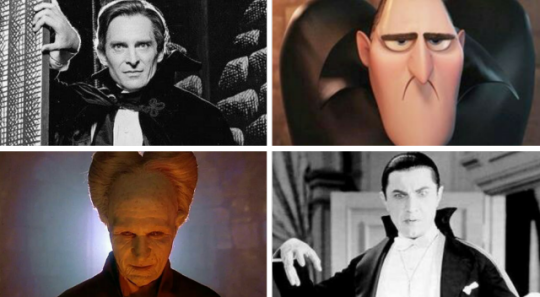
[Image ID: Various actors as Dracula. Jeremy Brett in 'Dracula' (1978) (upper left), Adam Sandler in a voice role for 'Hotel Transylvania' (2012) (upper right), Gary Oldman in 'Dracula' (1992) (lower left), and Bela Lugosi in 'Dracula' (1933) (lower right). End ID]
For instance, Bram Stoker's 'Dracula' (the second most adapted literary character, next to the consulting detective himself) has been portrayed on the screen over 200 times — from Gary Oldman to Adam Sandler — and has spawned off numerous books and pastiches of its own such as Stephen King's 'Salem's Lot'. Its cultural impact served as a basis of how we see vampires today, since some characteristics of the Count were made by Stoker himself. Stoker's creation is the brainchild of his predecessors and inspirations.

[Image ID: Vlad the Impaler (left) and a book cover of 'Carmilla' by J. Sheridan Le Fanu (right). End ID]
Other than the ongoing hysteria over dead back then and the existing vampire folklore, Stoker also took his inspirations from the published books on vampires he had at hand. He is said to have taken inspiration from Vlad the Impaler, a Romanian national hero known allegedly for having impalement as his favourite method of torture. He is also said to have been inspired by the J. Sheridan Le Fanu's 'Carmilla', a Gothic lesbian vampire novella that predates Dracula by 26 years. I could go on, but hey, we're going back to Sherlock Holmes now before I deviate any further. However, if you want to know about Dracula's literary origins, I suggest you watch Ted-ED's videos about the subject matter such as this one or this one.
Very much like Stoker, ACD didn't just conceive Holmes on his own. He took his own inspirations from what he had available at the time.

[Image ID: Dr Joseph Bell (left) and Edgar Allan Poe (right). End ID]
As we all know, ACD's biggest inspiration for Sherlock Holmes was one of his teachers at the Edinburgh University, Joseph Bell. He was famous for his powers of deduction, and he was also interested in forensic science — both characteristics which Holmes is greatly known for. He also drew inspiration from Edgar Allan Poe's sleuth, C. Auguste Dupin ('The Purloined Letter' & 'Murders in Rue Morgue'). As ACD himself has said at the 1909 Poe Centennial Dinner: "Where was the detective story until Poe breathed life into it?" Some other writers he took after are Wilkie Collins, Émile Gaboriau, and Oscar Wilde.
Now, what does this say about us Sherlockians/Holmesians (depending if you're the coloniser or the one that was colonised)? Basically, ACD laid the groundwork for us with Sherlock Holmes: his humble abode 221B that he shares with his flatmate Dr. John Watson, his adventures, memoirs, return, casebook, last vow, and all that. Now that we have this material at hand, we can now make our own versions, takes, or even original stories featuring the characters of the Canon. Our inspiration comes from ACD's Sherlock Holmes, and we now get the chance to make our very own stories/conspiracy theories about them.
As I have mentioned earlier, Sherlock Holmes is the most adapted literary character in history. He has been adapted in over 200 films, more than 750 radio adaptations, a ballet, 2 musicals; and he's become a mouse, a woman, a dog, even a bloody cucumber. On top of all that are numerous pastiches and fanfics, and finally, we have arrived at the main topic of our post!
Fanfiction and pastiche are often confused together since they have three common elements: they take after the original work, they usually use the characters in that original work, and more often than not do are they set in that same time frame/period or not long after that. The common misconception is that pastiche are printed fanfiction, which is only partly true. While pastiche is definitely fanfiction in some ways and vice versa, there are fanfictions out there that aren't necessarily classified as pastiche that have been published.
Let's get on with our definition of terms to clear up the confusion a little more. Pastiche, according to Literary Terms, is:
. . . a creative work that imitates another author or genre. It’s a way of paying respect, or honor, to great works of the past. Pastiche differs from parody in that pastiche isn’t making fun of the works it imitates – however, the tone of pastiche is often humorous.
A good example of a pastiche is Sophie Hannah's 'The Monogram Murders', which is her take from Agatha Christie's Hercule Poirot.
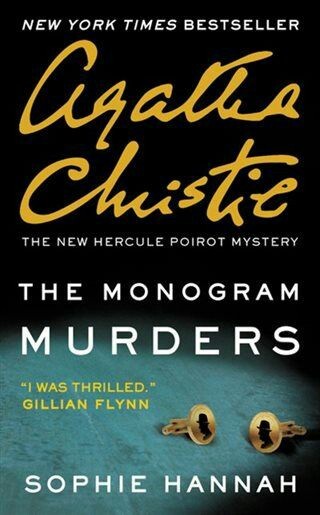
[Image ID: A book cover of 'The Monogram Murders' by Sophie Hannah. End ID.]
Although this was a commission from Christie's estate, it's still considered as a pastiche as:
It's takes after Christie's writing style;
It is set in the early years of Poirot's career (1929), which is still within the time frame that the author wrote him in;
It features Poirot and;
It pays respect to Christie in a sense that it stays true to her (Christie) characters and way of storytelling.
Meanwhile, our good and slightly unreliable friend Wikipedia defines fanfiction as:
. . . is fictional writing written by fans, commonly of an existing work of fiction. The author uses copyrighted characters, settings, or other intellectual property from the original creator(s) as a basis for their writing. [It] ranges from a couple of sentences to an entire novel, and fans can both keep the creator's characters and settings and/or add their own. [ . . . ] [It] can be based on any fictional (and sometimes non-fictional) subject. Common bases for fanfiction include novels, movies, bands, and video games.
To avoid any copyright infringement issues if I ever use a popular fanfic in the fandom, we'll use my (unfinished and unpopular) Sherlock Wattpad fic, 'Play Pretend'. You can read it here.

[Image ID: The second self-made book cover of Blessie/shezzaspeare's 'Play Pretend'. End ID]
Why is it considered a fanfiction and not a pastiche?
It takes after an adaptation of Sherlock Holmes (BBC Sherlock) which is a TV show, not the ACD canon itself;
The author (in this case myself) uses her own writing style and does not take after the original story's style;
Although it is set well in modern-day London and after Season 4, it also features scenes decades before the actual fanfic is set and outside of London;
I added a considerable number of characters, i.e. siblings to canon characters;
I had my own take some of the canon characters' personality especially after the events of Sherrinford;
It is written by a fan – myself. It is a work of fan labour and;
It is only a work of fanon, and isn't likely going to be considered by the show as its writing style is different from the actual show.
To put it simply, you can have more freedom in a fanfiction as it does not necessarily restrict you to follow or take after the original stories. Alternate universes (AUs) such as Unilock and Teenlock are perfect examples of this thing.
So can a pastiche be classified as fanfiction? Yes.
Can a fanfiction be classified as pastiche? Not all the time.
What's the difference? While yes, they share the basics, pastiche is technically leans more onto the original work's fundamental elements whereas fanfiction is a broader range of works inspired by the original work but doesn't necessarily follow all or any of its fundamental elements.
In order for us to understand it more, I'll give another example.

[Image ID: The 'Enola Holmes' title card (upper left) and Henry Cavill as its Sherlock holmes (upper right). Underneath it is a a scene from the opening titles of BBC Sherlock (lower left) and Benedict Cumberbatch as Sherlock Holmes in A Scandal In Belgravia. (lower right) End ID]
Most of you are familiar with these 21st-century adaptations of Holmes: the 2020 adaptation of Nancy Springer's Enola Holmes books and BBC Sherlock, which needs no further explanation – but for those who don't know, it's basically Holmes and the gang if they were alive today. I specifically chose these two as they are the ones that I believe would get my points across best. Though both are considered as wonderful pastiches with a well-rounded cast and awesome visuals, if we break them down bit by bit, we'll see which one is more of a pastiche and which one is more of a fanfic. (Yes, I know they're both screen adaptations. However, as Enola Holmes was based on the books and BBC Sherlock's fanfiction has the show's scenes written out in most fanfics, hear me out.)
They share these characteristics of a pastiche:
They feature characters from the Canon (Sherlock Holmes, Mycroft Holmes, and Lestrade);
They have additional characters added by the writers (Including but not limited to Molly Hooper, Eurus Holmes, and Philip Anderson for BBC Sherlock while Enola Holmes has Lord Tewkesbury, Eudoria Holmes, and Enola herself) and;
They pay respect to the original Canon as their stories are based on the cases (BBC Sherlock) or simply what was going on around them (Enola Holmes).
They also share these characteristics of a fanfic:
They are made by enthusiasts of Sherlock Holmes (Moffat has called himself and Mark Gatiss 'Sherlock Holmes geeks', while Nancy Springer's Enola Holmes books are not just one or two but six);
They follow a common trope (we'll discuss these tropes in the following episodes) that goes on in the fandom (Sherlock's Sister & Modern AU)
They are based on a fictional subject (Sherlock Holmes);
They used characters and story elements that are copyrighted by the author/author's estate (fun fact: prior to the production of Enola Holmes, the Conan Doyle Estate filed a lawsuit against Springer & Netflix over Sherlock's emotions since he was more 'sympathetic' than he was portrayed in the Canon – this was later dismissed by both parties) and;
Their writing styles don't necessarily follow ACD's.
Despite these similarities, there are very obvious differences between the two that separates them from being a pastiche and a fanfiction.
Enola Holmes embodies pastiche more as it doesn't stray far away from the original elements of the Canon. It's still set in Victorian England. While Springer added characters of her own and definitely twisted the Canon to suit her series, she didn't necessarily place them out of the social construct that was going on around the characters. It follows ACD's writing style more as Enola Holmes' setting still remains within the Canon's original setting.
Meanwhile, we can safely say that BBC Sherlock is a work of fanfiction. While it did give us The Abominable Bride, the main series focused on Holmes and Watson in 21st-century England, which is drastically different from Victorian England. There are phones, black cabs, and cellphones — things which ACD Sherlock Holmes doesn't have. It also diverted from the Canon in the characters themselves, which is mostly seen in the names: Henry Baskerville became Henry Knight, Charles Augustus Milverton became Charles Augustus Magnussen, the H in Dr Watson's name stood for Hamish and Sherlock's full name is actually William Sherlock Scott Holmes. They also changed the personalities of some Canon characters: Mary was actually an ex-assassin, Mrs Hudson was an exotic dancer who drove a kick-ass sports car, Irene Adler is a dominatrix, to name a few. Moffat and Gatiss created a world of their own featuring the characters of Sir Arthur Conan Doyle, which is really what most of us fanfic writers do with Mofftiss' rendition of Holmes.
In conclusion: while pastiche and fanfiction could have been the same thing, they're actually not. There's more to them that just printed fanfiction or pastiche e-books, and we all should take some time to see and observe them in a closer perspective.
And that's it for our first episode! I hope you enjoyed it. It was a lot fun for me to write this, especially now that I'm only starting. I would also like to note that while intensive research has been done on this series, some parts of this comes from my own observation and opinion, which may vary from yours. I am very much open to criticism, as long as it is said in a polite and civil manner. I'm still young, and to be educated as I go is something that could really help me with this series.
Like and reblog this you like it. It helps out a lot. Be sure to follow me as well and the tags underneath if you want to see more of TSoF.
See you soon!
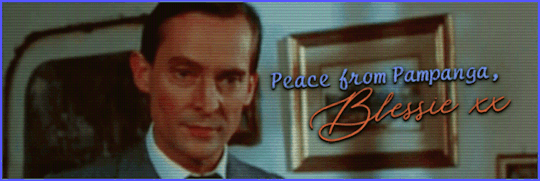
Blessie presents – The Science of Fanfiction: A Study In Sherlock (2021) • Next
Follow me! • My Carrd | My YouTube Channel
SOURCES • Pinterest, Google Images, Wikipedia, Literary Terms, Conan Doyle Estate, Definitions, The Sherlock Holmes Book, and Google
#the science of fanfiction#sherlock#sherlock holmes#johnlock#bbc sherlock#dracula#enola holmes#lord tewkesbury#jeremy brett#shezzaspeare#bram stoker#acd#canon#fanfiction#pastiche#holmes#adlock#sherlolly#molly hooper#greg lestrade
91 notes
·
View notes
Photo

“A father is the one friend upon whom we can always rely. In the hour of need, when all else fails, we remember him upon whose knees we sat when children, and who soothed our sorrows; and even though he may be unable to assist us, his mere presence serves to comfort and strengthen us.” - Émile Gaboriau Salute to the all hardworking and loving Dads in the world... HAPPY FATHER'S DAY!!! #fathersday #happyfathersday #greatestdad #dadsday #lovingfather #hardworkingfather #father #dad #positivity #positivevibes #happylife #happilyempowered https://www.instagram.com/p/CBrnttsjuBs/?igshid=15844u3bsorvl
#fathersday#happyfathersday#greatestdad#dadsday#lovingfather#hardworkingfather#father#dad#positivity#positivevibes#happylife#happilyempowered
0 notes
Photo

L'Affaire Lerouge est le plus célèbre roman policier de l'écrivain français Émile Gaboriau.
0 notes
Text
IXD304
Researching Sherlock Holmes
Sherlock Holmes is a fictional private detective created by the British author Sir Arthur Conan Doyle. Referring to himself as a "consulting detective" in the stories, Holmes is known for his high observation skills, experience in forensic science, as well as his logical reasoning that borders on the crazy to most who don’t know him well. He investigates cases for a wide variety of clients, including Scotland Yard.

First appearing in print in 1887's A Study in Scarlet, Sherlock’s popularity became widespread with the first series of short stories in The Strand Magazine, beginning with "A Scandal in Bohemia" in 1891. This series eventually totalled to four novels and 56 short stories. All but one are set in the Victorian or Edwardian eras, between about 1880 and 1914. Most are narrated by the character of Holmes's friend and biographer Dr. John H. Watson, who usually accompanies Holmes during his investigations and often shares quarters with him at the address of 221B Baker Street, London, where many of the stories begin.

Although Sherlock isn’t the first fictional detective in stories, Holmes is arguably the best known. By the 1990s, there were already over 25,000 stage adaptations, films, television productions and publications featuring the detective, and the Guinness World Records even lists him as the most portrayed literary human character in all of film and television history.
Holmes's popularity hit an all time high to the fact that many belief him to be a real person and not just a fictional character in story books. Fans of the franchise helped create the modern practice of fandom. The character and stories have had a profound and lasting effect on mystery writing and popular culture as a whole, with the original tales as well as thousands written by authors other than Conan Doyle being adapted into stage and radio plays, television, films, video games, and other media for over one hundred years.
The inspiration behind Sherlock Holmes stemmed from Edgar Allan Poe's C. Auguste Dupin which is generally acknowledged as the first detective in fiction. Similarly, the stories of Émile Gaboriau's Monsieur Lecoq were extremely popular at the time Conan Doyle began writing Holmes, and Holmes's speech and behaviour sometimes follow that of Lecoq. Holmes and Watson discuss Dupin and Lecoq near the beginning of A Study in Scarlet.
Conan Doyle repeatedly said that Holmes was inspired by the real-life figure of Joseph Bell, a surgeon at the Royal Infirmary of Edinburgh, whom Conan Doyle met in 1877 and had worked for as a clerk. Like Holmes, Bell was noted for drawing broad conclusions from minute observations. However, he later wrote to Conan Doyle: "You are yourself Sherlock Holmes and well you know it". Sir Henry Littlejohn, Chair of Medical Jurisprudence at the University of Edinburgh Medical School, is also cited as an inspiration for Holmes. Littlejohn, who was also Police Surgeon and Medical Officer of Health in Edinburgh, provided Conan Doyle with a link between medical investigation and the detection of crime.
Watson describes Holmes as "bohemian" in his habits and lifestyle. Described to have a "cat-like" love of personal cleanliness, Holmes is an eccentric with no regard for standard tidiness.
Watson describes him as
“in his personal habits one of the must untidy men that ever drove a fellow-lodger to distraction. [He] keeps his cigars in the coal-scuttle, his tobacco in the toe end of a Persian slipper, and his unanswered correspondence transfixed by a jack-knife into the very centre of his wooden mantelpiece. ... He had a horror of destroying documents.... Thus month after month his papers accumulated, until every corner of the room was stacked with bundles of manuscript which were on no account to be burned, and which could not be put away save by their owner.”
While Holmes can be dispassionate and cold, when pulled into an investigation, he is animated and excitable. He has a flair for showmanship, often keeping his methods and evidence hidden until the last possible moment so as to impress observers.
Except for that of Watson, Holmes avoids casual company. In "The Gloria Scott", he tells the doctor that during two years at college he made only one friend: "I was never a very sociable fellow, Watson ... I never mixed much with the men of my year".
The detective goes without food at times of intense intellectual activity, believing that "the faculties become refined when you starve them."
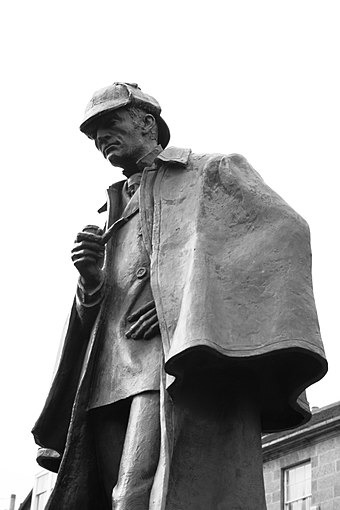
Although Holmes is not the original fictional detective, his name has become synonymous with the role. Doyle's Sherlock Holmes stories introduced multiple literary devices that have become major conventions in detective fiction, such as the companion character who is not as clever as the detective and has solutions explained to him (thus informing the reader as well), as with Dr. Watson in the Holmes stories. Other conventions introduced by Doyle include the arch-criminal who is too clever for the official police to defeat, like Holmes's adversary Professor Moriarty, and the use of forensic science to solve cases.
The Sherlock Holmes stories established crime fiction as a respectable genre popular with readers of all backgrounds, and Doyle's success inspired many contemporary detective stories. Holmes influenced the creation of other "eccentric gentleman detective" characters, like Agatha Christie's fictional detective Hercule Poirot, introduced in 1920.
The phrase "Elementary, my dear Watson" has become one of the most quoted and iconic aspects of the character. However, although Holmes often observes that his conclusions are "elementary", and occasionally calls Watson "my dear Watson", the phrase "Elementary, my dear Watson" is never uttered in any of the sixty stories by Conan Doyle. One of the nearest approximations of the phrase appears in "The Adventure of the Crooked Man" when Holmes explains a deduction: "'Excellent!' I cried. 'Elementary,' said he."
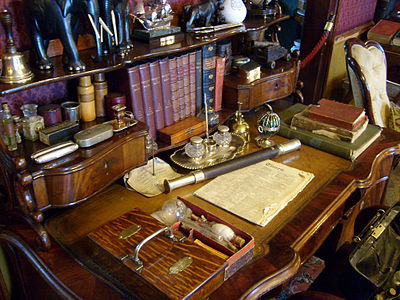
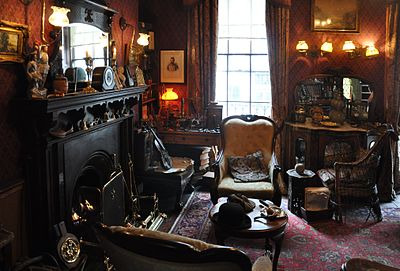
For the 1951 Festival of Britain, Holmes's living room was reconstructed as part of a Sherlock Holmes exhibition, with a collection of original material. After the festival, items were transferred to The Sherlock Holmes (a London pub) and the Conan Doyle collection housed in Lucens, Switzerland by the author's son, Adrian. Both exhibitions, each with a Baker Street sitting-room reconstruction, are open to the public.
In 1969, the Toronto Reference Library began a collection of materials related to Conan Doyle. Stored today in Room 221B, this vast collection is accessible to the public. Similarly, in 1974 the University of Minnesota founded a collection that is now "the world’s largest gathering of material related to Sherlock Holmes and his creator". Access is closed to the general public, but is occasionally open to tours.
In 1990, the Sherlock Holmes Museum opened on Baker Street in London. A private Conan Doyle collection is a permanent exhibit at the Portsmouth City Museum, where the author lived and worked as a physician.
Sources:
https://en.wikipedia.org/wiki/Sherlock_Holmes
0 notes
Video
youtube
Monsieur Lecoq | Émile Gaboriau | Crime & Mystery Fiction, Romance | Audiobook full unabridged | French | 1/16 Content of the video and Sections beginning time (clickable) - Chapters of the audiobook: please see First comments under this video. Ce roman policier, historique et d'amour, mené de main de maître, en passionnera plus d'un : Vers onze heures du soir, le dimanche gras de 18.., non loin de l'ancienne barrière d'Italie, des cris effroyables, lancés de la Poivrière, parviennent à la ronde d'agents du service de la sûreté menée par l'inspecteur Gévrol. Ces hommes accourent. Un triple meurtre vient d'être commis. L'assassin est pris sur le fait. Contrairement à Gévrol, qui conclut que quatre coquins se sont rencontrés dans ce coupe-gorge, qu'ils se sont pris de querelle, que l’un d’eux avait un revolver et a tué les autres, Lecoq, nouvelle recrue, entrevoit un grand mystère. La piste trouvée, il ne la lâchera plus. Et vous ? (par Ezwa) Monsieur Lecoq is a captivating mystery, historical and love story : Around 11 o'clock, on the evening of Shrove Sunday 18.., close to the old Barrière d'Italie, frightful cries, coming from Mother Chupin's drinking-shop, are heard by a party of detectives led by Inspector Gévrol. The squad runs up to it. A triple murder has just been committed. The murderer is caught on the premises. Despite Gévrol's opinion that four scoundrels encountered each other in this vile den, that they began to quarrel, that one of them had a revolver and killed the others, Lecoq, a young police agent, suspects a great mystery. He will lead his investigation until he gets to the bottom of it. Will you follow him? (Summary by Ezwa) This is a Librivox recording. If you want to volunteer please visit https://librivox.org/ by Priceless Audiobooks
0 notes
Text
The Honor of the Name

The Honor of the Name
Émile Gaboriau
Published: 1891
Fiction, Action & Adventure, Mystery & Detective, Historical
Formats: Word & PDF, 472 pages
📂Download for free in PDF format
Read the full article
0 notes
Photo

We would like to congratulate all the men out there who are working diligently every day to shape up the present and future of their children. ⠀ ⠀ Work and family are challenging, and you deserve major kudos for ALL you do.⠀ "A father is the one friend upon whom we can always rely. In the hour of need, when all else fails, we remember him upon whose knees we sat when children, and who soothed our sorrows; and even though he may be unable to assist us, his mere presence serves to comfort and strengthen us.” —Émile Gaboriau⠀ ⠀ #FathersDay #father #fathers #fatherhood — view on Instagram http://bit.ly/2KmhyG4
0 notes
Photo




Hey speed-readers. With 221b Con fast approaching it’s not too late to dive in to our 221b Con recommended reading list.
This year’s book club discussion choices:
The Annual 221b Con Canon Book Club
This year’s theme is ‘The Jewels in the Crown’.
We will be discussing The Adventure of the Golden Pince-nez, Silver Blaze, The Adventure of the Copper Beeches, The Adventure of the Beryl Coronet, and The Adventure of the Mazarin Stone. So break out your annotated canon and join us for some fun.
Jane Steele by Lyndsay Faye
A Gothic retelling of Jane Eyre.
Like the heroine of the novel she adores, Jane Steele suffers cruelly at the hands of her aunt and schoolmaster. And like Jane Eyre, they call her wicked - but in her case, she fears the accusation is true. When she flees, she leaves behind the corpses of her tormentors.
A fugitive navigating London's underbelly, Jane rights wrongs on behalf of the have-nots whilst avoiding the noose. Until an advertisement catches her eye. Her aunt has died and the new master at Highgate House, Mr Thornfield, seeks a governess. Anxious to know if she is Highgate's true heir, Jane takes the position and is soon caught up in the household's strange spell. When she falls in love with the mysterious Charles Thornfield, she faces a terrible dilemma: can she possess him - body, soul and secrets - and what if he discovers her murderous past.
https://www.amazon.com/Jane-Steele-Lyndsay-Faye/dp/0425283208/ref=sr_1_1?ie=UTF8&qid=1490507548&sr=8-1&keywords=jane+steele
Additional Recommended Reading:
Arthur and Sherlock by Michael Sims
As a young medical student, Arthur Conan Doyle studied in Edinburgh under the vigilant eye of a diagnostic genius, Dr. Joseph Bell. Doyle often observed Bell identifying a patient's occupation, hometown, and ailments from the smallest details of dress, gait, and speech. Although Doyle was training to be a surgeon, he was meanwhile cultivating essential knowledge that would feed his literary dreams and help him develop the most iconic detective in fiction.
Michael Sims traces the circuitous development of Conan Doyle as the father of the modern mystery, from his early days in Edinburgh surrounded by poverty and violence, through his escape to University (where he gained terrifying firsthand knowledge of poisons), leading to his own medical practice in 1882. Five hardworking years later--after Doyle's only modest success in both medicine and literature--Sherlock Holmes emerged in A Study in Scarlet. Sims deftly shows Holmes to be a product of Doyle's varied adventures in his personal and professional life, as well as built out of the traditions of Edgar Allan Poe, Émile Gaboriau, Wilkie Collins, and Charles Dickens--not just a skillful translator of clues, but a veritable superhero of the mind in the tradition of Doyle's esteemed teacher.
https://www.amazon.com/Arthur-Sherlock-Conan-Creation-Holmes/dp/1632860392
Scarlet in Gaslight by Martin Powell
Sherlock Holmes, Dracula. An epic mystery pits the super sleuth against the supernatural forces of the evil count as Moriarty has enlisted the aid of Dracula to plunge London into a new dark age. Holmes, with the assistance of Professor Van Helsing, must turn to the famed actress Sarah Bernhard to uncover the clues that will bring this impossible case to a close.
https://www.amazon.com/Scarlet-Gaslight-Martin-Powell/dp/0944735096/ref=asap_bc?ie=UTF8
31 notes
·
View notes
Text
A Brief History of Mystery Books
What exactly is a mystery book?
In a mystery novel, a crime is committed. The crime is commonly a murder, but thefts or kidnappings are also popular. The action of the story revolves around the solution of that crime – determining who did it and why, and ideally achieving some form of justice.
There are many specific subtypes within the mystery genre: police procedurals, hard-boiled detective stories, espionage thrillers, medical or forensic mysteries, cozy mysteries, closed-room mysteries, and courtroom dramas, to name a few. As myriad as they sound, they all sprouted from the same authors and history.
This copy of The Murders in the Rue Morgue is a 1932 “photoplay edition” listed for sale by Heritage Book Shop.
The beginning of the mystery genre
The rapid growth of urban centers in the 19th century meant that more police were needed. This spurred the advent of professional detectives whose chief job was to investigate crimes. Although there are examples of puzzle stories that reach back through time to when some of the earliest poems or tales were written down, most people agree that the first modern ‘detective story’ is The Murders in the Rue Morgue by Edgar Allan Poe. First published in the April 1841 issue of Graham’s Magazine, the short story tells the tale of an amateur detective who sets out to solve the grisly murders of a mother and daughter within a locked room of their apartment on the Rue Morgue.
Nearly twenty years after Poe’s story, Wilkie Collins published The Woman in White (1859), which is considered the first mystery novel, and The Moonstone (1868), generally considered the first detective novel. The Woman in White is a gripping tale of murder, madness and mistaken identity that is so beloved it has never been out of print. Collins had “Author of The Woman in White and other works of fiction” engraved on his tombstone. The Moonstone set the standards for the detective novel formula – an enormous diamond is stolen from a Hindu temple and resurfaces at a birthday party in an English manor, and with numerous narrators and suspects, the story weaves through superstitions, romance, humor and suspicion to solve the puzzle.
The Moonstone’s title as the first detective novel is contested by two other books. The first, The Notting Hill Mystery, was published in 1865 and written under the pen name Charles Felix, who is believed to be Charles Warren Adams, sole proprietor of the publishing house Saunders, Otley, and Company. In The Notting Hill Mystery, the main character figures out the culprit of murder through diary entries, family letters, chemical analysis, depositions, and a crime scene map. Many of these detective techniques were not used again until the novels of the 1920s.
A French mystery, L’Affaire Lerouge (1866) by Émile Gaboriau, is also considered a pioneering detective novel. One of the first stories to use the gathering of evidence to solve the murder mystery, it combines police intrigue and a love story – two mothers, two sons, and one father (a Count). L’Affaire Lerouge, first published in English as The Widow Lerouge or The Lerouge Case, introduced the concept of an amateur detective as well as a recurring character trope, featuring a young police officer named Monsieur Lecoq who was featured in several of Gaboriau’s later novels.
This first American edition of The Leavenworth Case: A Lawyer’s Story is listed by Lucius Books
Early Mystery Novels
The Dead Letter, published in 1866 by Beadle’s Monthly Magazine, is credited with being the first detective story by a woman. It was written under the name Seeley Regester, a nom de plume for author Metta Victoria Fuller Victor who wrote more than 100 dime novels. The Dead Letter is also the first full-length American work of crime fiction.
In 1878, Anna Katherine Green introduced the first American detective in The Leavenworth Case. The Leavenworth Case is widely noted as one of the first American bestsellers, selling 750,000 copies in its first decade and a half of publication. Green would pave the way for many prolific and talented women writers in the genre.
But unlike The Leavenworth Case that eventually fell out of favor and out of print, Robert Louis Stevenson, who had success with Treasure Island in 1883, published the classic mystery The Strange Case of Dr. Jekyll and Mr. Hyde in 1886. Initially sold as a ‘penny dreadful’ in the UK and US, more than 40,000 copies of the book had been sold within six months, and soon after more than 250,000 copies were pirated in America. The book and its characters have infiltrated not only literature but also film, television, and popular culture ever since.
The first edition of Strange Case of Dr. Jekyll and Mr. Hyde listed by Second Story Books
1886 was also the year The Mystery of a Handsom Cab was published in Australia, written by Fergus Hume. The mystery about a body discovered in a Handsom cab in the city of Melbourne was very successful in Australia, and it went on to be published in America and Britain, selling over 500,000 copies worldwide. The Mystery of a Handsom Cab initially outsold a new release by Arthur Conan Doyle, one that introduced a character that would soon take over the world of detective fiction.
In 1887, Arthur Conan Doyle sold the rights to a story called A Study in Scarlet for £25. It was published first in Beeton’s Christmas Annual, and later in 1888 as a novel by Ward, Lock & Co. Doyle was 27 years old when it was published and wrote the story in a reported three weeks. A Study in Scarlet was the first work to feature Sherlock Holmes and Dr. Watson. Doyle went on to write 56 short stories featuring Holmes and a total of four full-length novels in what is considered the Canon of Sherlock Holmes. The novels in the Canon following A Study in Scarlet are The Sign of Four (1890), The Hound of the Baskervilles (1901-1902) and The Valley of Fear (1914-1915).
This copy of A Study in Scarlet belonged to John Keynes. Listed by John Atkinson.
Mary Roberts Rinehart published The Circular Staircase in 1908, creating the ‘had I but known’ school of mystery writing. The Circular Staircase, about a spinster aunt who solves mysteries at a rented summer house, became a best-seller and made Rinehart a household name. She wrote hundreds of stories and forty novels. At her death, her novels had sold 10 million copies, and it is said at her prime she sold more books than Agatha Christie, to whom she’s often compared, although many of her works pre-date Christie’s.
The Innocence of Father Brown (1911), a collection of 12 stories, started the prolific career of G. K. Chesterton, who is credited with being the father of the ‘cozy’ mystery. Father Brown solved crimes more by intuition and a deep understanding of human nature than by experimentation and scientific deduction.
1915’s The Thirty-Nine Steps by John Buchan is one of the earliest ‘man-on-the-run thrillers that would later be a popular plot device for mysteries and often used in movies as well. In the novel, Richard Hannay, an expatriate Scot, is an ordinary man met by extraordinary circumstances, who puts his own safety and interests aside to protect his country at the outset of WWI. The novel was very popular with troops during the First World War, and the author followed it up with multiple sequels.
And into the Golden Age…
These books all led up to what is considered ‘The Golden Age’ of crime writing in the 1920s and 1930s. Many of the most beloved authors of this period were British and writing in either the ‘cozy’ or ‘country house’ mystery style. Agatha Christie, Dorothy Sayers, Margery Allingham, and Ngaio Marsh are often dubbed the Queens of this Golden Age. Quite a few American writers followed suit until some broke out in a distinct ‘hard-boiled’ style as “pulp” novels were popularized.
The popularity of detective fiction waned with the outbreak of WWII, never again reaching the peak of the Golden Age, yet many mystery books continue to be published and consumed in the subsequent decades.
We’ll be taking a look at the most collectible mystery novels in our Book Collecting By the Year series starting on January 30. Want to get updates in your inbox when we add a new decade? Join our mailing list here.
The post A Brief History of Mystery Books appeared first on Bibliology.
source https://www.biblio.com/blog/2020/01/a-brief-history-of-mystery-books/
1 note
·
View note